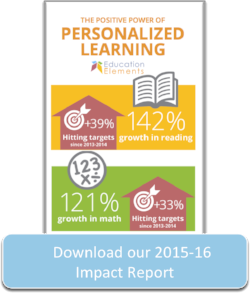
creating an entrepreneur’s mindset through a personalized learning approach
personalized learning | innovative leadership
it seems like everyone’s priority in education is to become a 1:1 district with ubiquitous access to technology and internet connectivity both at school and home. the new e-rate program will certainly move us in that direction, and the new every student success act (essa) should provide guidance and accountability. but will all this make a difference, and are we using the proper approach to prepare our next generation of learners?
often when i speak with educators, their measure of success for being technology-driven is if they have been able to provide students with devices. in fact, too much emphasis is placed on which device to purchase when the conversation should be device agnostic and more centered on the technology infrastructure and connectivity. living in this panacea may transform our students as 21st century learners, but that is not enough. although there is a major shift toward digital transformation and innovation in our schools, administrators need to understand how to connect the dots and develop a comprehensive implementation plan that impacts student learning. the plan needs to focus on the technology, the infrastructure, professional learning, and teaching and learning.
a good place to begin the process and/or validate that the district is headed in the right direction is to have the leadership team collectively take the future ready (fr) assessment tool. the comprehensive report from this free assessment tool will help guide the development of an effective implementation plan consisting of seven gears working in alignment to produce an action plan.
this collaborative process of taking the fr assessment provides a professional learning opportunity to build innovative leadership capacity within your team. the leadership team will benefit from this process and understand the major implementation shifts and design elements for the appropriate technology solutions. through the assessment dashboard, the leadership team will discover where it is on the continuum for the digital conversion, identify gaps, access strategies, and review its progress toward the development of a robust technical and human infrastructure.
what innovative leaders will learn from this process is the need to move beyond thinking about 21st century learning skills as technology-based and focus instead on creating a personalized learning environment which prepares students for college, career, and life readiness. linking the learning in the classroom to a real world setting makes the learning relevant and brings life to the curriculum so that students are engaged and feel connected to their future career path.
one concept is to design a personalized learning model that builds on the learning outcomes to develop student as entrepreneurs. this does not imply that students must start their own business, yet it does require students to develop an “entrepreneurial mindset” where they can think, act, feel, and behave like an entrepreneur. millennial students are wired to develop these creative skills sets when they are young. providing learning opportunities around project based activities and designing strategies as if they are starting their own business prepares them to think like an entrepreneur.
think about it: why can’t we create a learning environment in schools where student design a project to solve a problem where they can apply those skills to a real world setting? how exciting would that be! imagine the answer to the question “what did you do in school today?” when what students did in school has a real connection to problems they see in the world and their ability to solve them.
a true entrepreneur is able to identify a real world problem and fill the gap by designing a solution to meet the needs of society. wouldn’t going to school be more fun, engaging and relevant if students could do this too? we often hear the stories about a college dropout who ends up becoming a great entrepreneur by designing a product that we all want to buy. so why can’t our students start in high school to come up with similar solutions? they can, we the adults just need to help change the system to allow our students to become creative innovators and release the power of their creative minds. students have the capacity to actually design a project, or better yet, create a solution to solve a hairy, audacious problem that people deal with every day. we just need to give them the time, resources, tools, and coaching to step out of their comfort zone.
so now is the time to go beyond the 1:1 devices and technology integration and change the learning system to create entrepreneurial students who graduate with the skills for college, career, and life. we may just engage students in their learning and witness less discipline problems, fewer suspensions, a lower dropout rate, and a higher graduation rate. sounds like this may even address your district’s local control accountability plan goals in california and the every student succeed act (essa) guidelines!
---
about dr. gabe soumakian
dr. gabe soumakian is a retired superintendent who was selected as a new member of the digital promise league of innovative schools for his leadership. he has been actively involved and presented at numerous leadership organizations at the state and national level on personalized digital learning and linked learning academies. his passion is supporting districts with the digital transformation and preparing students for college, career, and life readiness. dr. soumakian has served on the future ready leader panel of visionary educators, and the naf leadership fellow. he was recognized as one of ten superintendent who was accepted as a lexington education leadership award (lela) fellow in conjunction with edelements. dr. soumakian has over 35 years of education experience, including 18 years of high school teaching. his consulting group sup du jour focuses on leadership and vision supporting districts through education technology and digital transformation.



